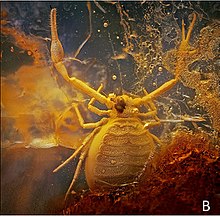Pseudogarypus synchrotron
| Pseudogarypus synchrotron Temporal range:
| |
|---|---|

| |
| specimen in Baltic amber | |
| Scientific classification | |
| Domain: | Eukaryota |
| Kingdom: | Animalia |
| Phylum: | Arthropoda |
| Subphylum: | Chelicerata |
| Class: | Arachnida |
| Order: | Pseudoscorpiones |
| Family: | Pseudogarypidae |
| Genus: | Pseudogarypus |
| Species: | †P. synchrotron
|
| Binomial name | |
| †Pseudogarypus synchrotron Henderickx, 2012
| |
Pseudogarypus synchrotron is an
History and classification
Pseudogarypus synchrotron is known from two separate fossils, the
The type specimens were first studied by paleoarachnologist Hans Henderickx of the University of Antwerp with Paul Tafforeau and Carmen Soriano, both of the European Synchrotron Radiation Facility. Henderickx's 2011 type description of the new genus and species was published in the journal Palaeontologia Electronica.[1] The specific epithet synchrotron is in reference to the synchrotron equipment that facilitated the description of areas of the specimen not visible to the naked eye.[1]
Description
Pseudogarypus synchrotron adults are mid-sized for Pseudogarypus, with a body length of approximately 2.5 millimetres (0.098 in), and show the distinctive body structuring that has horn-like protrusions, projecting ridges and a reticulate patterning to the carapace. This combination of features is found only in Pseudogarypus, making the genus placement easily recognizable. The chelae are distinctly elongated with a length to width ratio of 5:1; only those of Pseudogarypus extensus, also known from Baltic amber, are longer. The mobile finger of the chela has 24 teeth on its inner surface while the fixed finger has 33. The original coloration of the species is not identifiable due to the orange color-yellowish of the amber that encloses the specimens. The oval abdomen is longer than it is wide and has a generally teardrop shape. The thorax hosts two sets of horn-like protrusions, giving it an uneven outline with the larger "horns" placed to the rear.[1]
References
External links
![]() Media related to Pseudogarypus synchrotron at Wikimedia Commons
Media related to Pseudogarypus synchrotron at Wikimedia Commons
